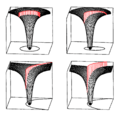Parabolic trajectory facts for kids
A parabolic trajectory is a special path an object takes in space. It's like a curved line called a parabola. When an object, such as an asteroid or a comet, follows this path around a planet or a star, it means it has just enough speed to escape that object's gravity forever.
This kind of movement follows important rules called Kepler's Laws, which explain how planets and other objects move around the Sun. A parabolic trajectory happens when something called the eccentricity of its orbit is exactly 1. Eccentricity tells us how "stretched out" an orbit is. If it's 1, the path is a parabola.
Other ways objects can move in space include a circular orbit (like Earth around the Sun, almost), an elliptical orbit (a slightly stretched circle), or a hyperbolic trajectory (a path where the object also escapes gravity, but with even more speed).
Contents
What is a Parabolic Trajectory?
A parabolic trajectory describes the path of an object that is moving around a much larger object, like a planet or a star. It's a specific type of orbit where the object has exactly the right amount of speed to break free from the larger object's gravity. Think of it as a one-way trip!
How Objects Follow This Path
When an object is on a parabolic path, it gets close to the main body, speeds up, and then flies away, slowing down as it gets farther. But it never truly stops or falls back. It will keep moving away from the central object forever, though its speed will get closer and closer to zero.
Eccentricity and Orbital Shapes
The shape of an object's orbit is described by its eccentricity. This is a number that tells us how round or stretched out an orbit is.
- If eccentricity is 0, the orbit is a perfect circle.
- If eccentricity is between 0 and 1, the orbit is an ellipse (an oval shape). Most planets have elliptical orbits.
- If eccentricity is exactly 1, the orbit is a parabola. This is the special case where an object can escape.
- If eccentricity is greater than 1, the orbit is a hyperbola. This means the object has even more speed than needed to escape.
Kepler's Laws of Motion
The movement of objects on a parabolic trajectory, just like all other orbits, follows Kepler's Laws. These laws were discovered by Johannes Kepler in the early 1600s. They explain how planets move around the Sun, but they apply to any two objects interacting through gravity. For a parabolic path, Kepler's laws still describe how the object's speed changes as it moves closer or farther from the central body.
Examples in Space
While perfect parabolic trajectories are rare, some comets or asteroids might follow paths very close to a parabola. This means they are visitors to our Solar System that will pass by the Sun once and then leave, never to return. They have just enough energy to escape the Sun's powerful gravity.
Images for kids
See also
 In Spanish: Trayectoria parabólica para niños
In Spanish: Trayectoria parabólica para niños


